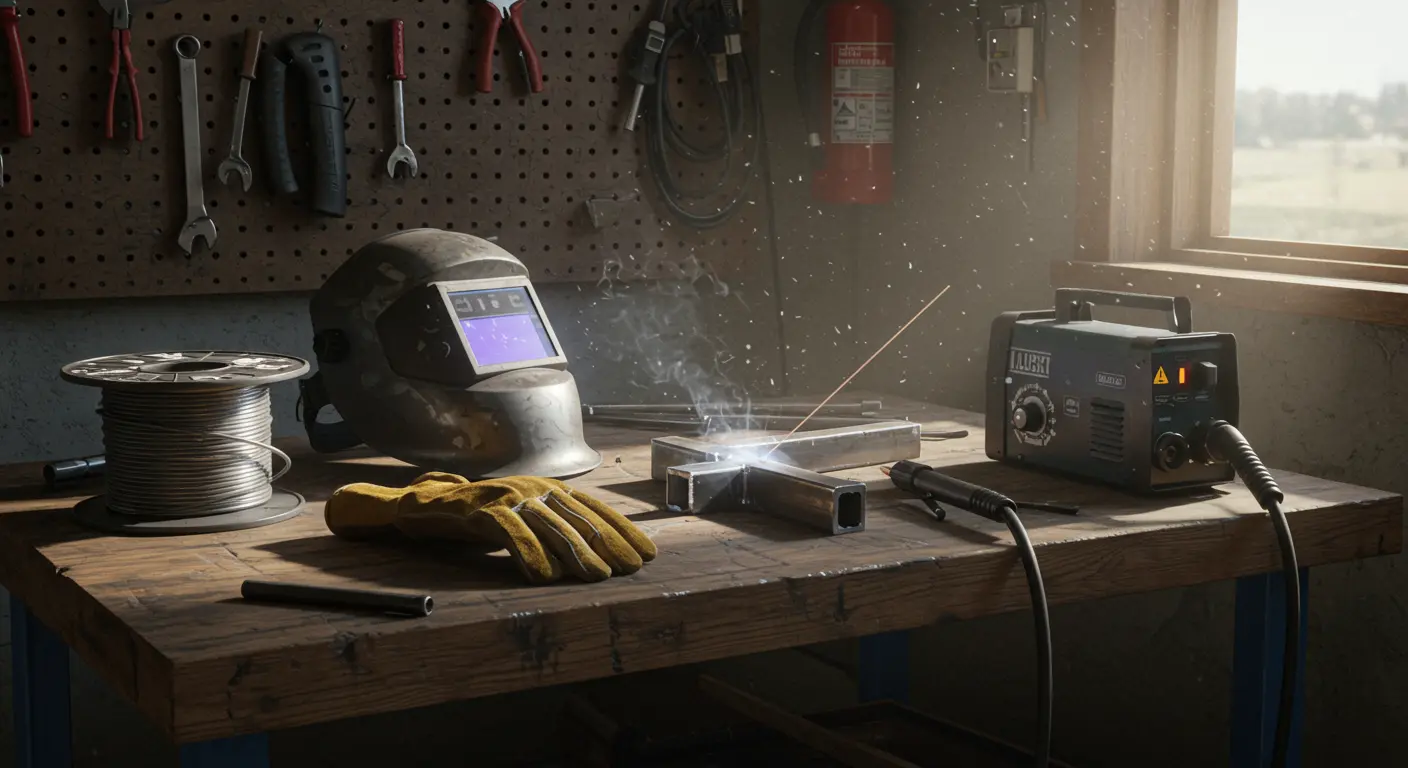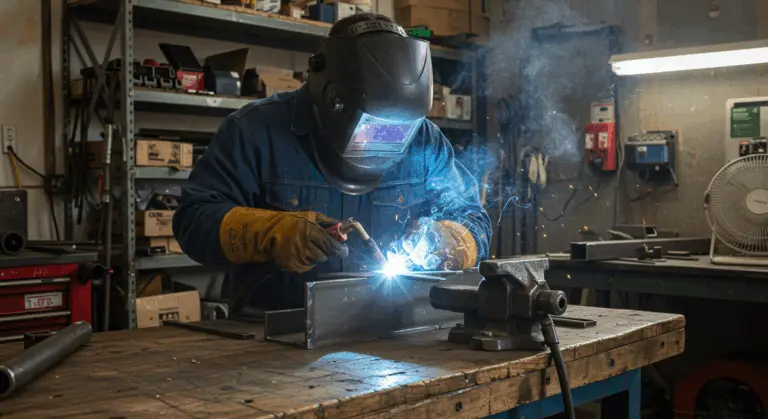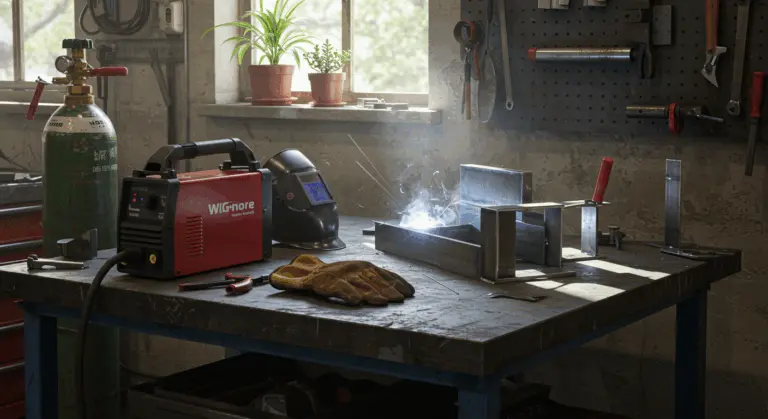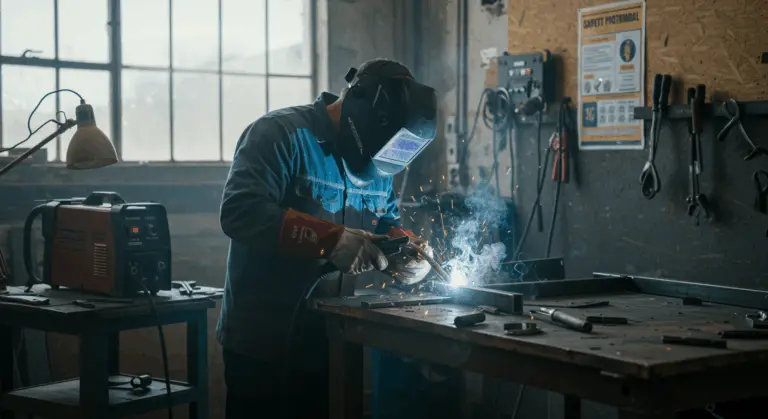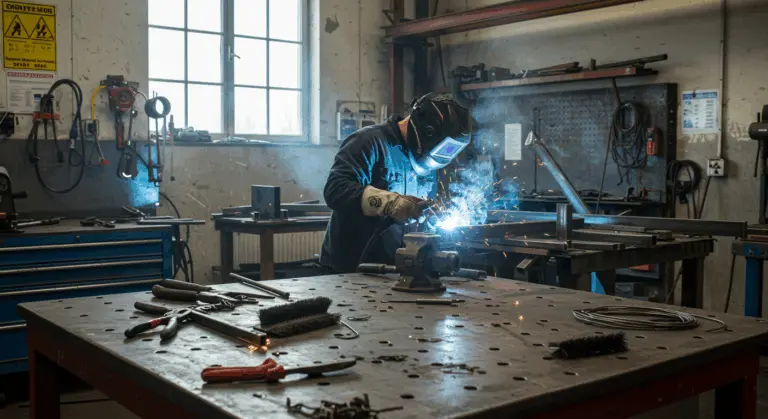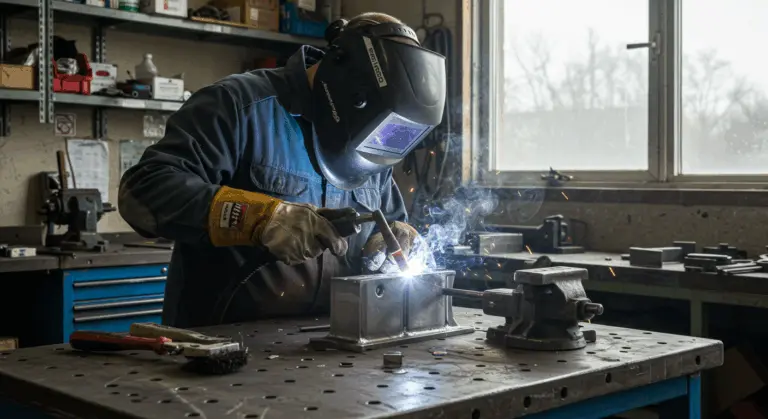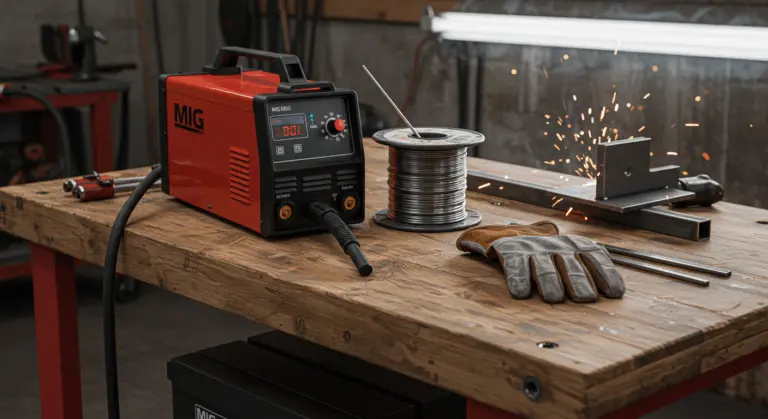Understanding Flux-Cored Arc Welding (FLAW)
Flux-cored arc welding (FLAW), also known as dual shield welding, emerged in the 1950s as a practical alternative to manual metal arc (MMA) welding. This semi-automatic process employs equipment remarkably similar to MAG welding—featuring a continuous wire-fed electrode paired with a constant-voltage power supply.
An electric arc forms between an electric arc forms between the workpiece and a continuously-fed tubular filler wire. Both materials melt and fuse, creating strong welds. What sets this process apart? The wire’s ingenious hollow design houses powdered flux that generates a protective shield during welding.
FLAW is available in two main varieties, which determines its application:
-
Self-shielded (FLAWS / 138): The flux core generates its own protective atmosphere, making it ideal for outdoor work and portable applications.
-
Gas-shielded (FLAG / 136): Uses an external shielding gas in addition to the flux. This type generally produces higher quality welds with deeper penetration and less spatter.
Self-shielded FLAW excels in outdoor environments. Why? Its self-generating gas shield eliminates the hassle of external gas cylinders, making it perfect for field repairs and tackling thick metals. Yes, you’ll need to clean off the resulting slag, but the results are excellent—strong, reliable welds for the most demanding applications.
Preparing Your Metal for Welding
Proper metal preparation is essential for successful flux core welding. Even masterful technique cannot salvage a poorly prepared surface. Start by creating a clear assembly plan—visualize how your pieces will fit together before striking the first arc.
Surface cleanliness is essential for preventing porosity and other defects. Eliminate all contaminants—rust, grease, paint, and oil—using solvents combined with mechanical methods like wire brushes or grinders. While FLAW wires contain deoxidizers that handle minor impurities, they cannot replace thorough cleaning.
Thicker materials demand proper edge preparation to achieve full joint penetration. Bevel the edges according to your joint type and material thickness. Use coarser abrasive grits for initial cleaning, then switch to finer grits for that final, pristine preparation.
Strategic tack welding prevents movement and misalignment during the main welding sequence. Working with materials prone to heat distortion? Weld in short sections, allowing the metal to cool between passes. A wet cloth or brass backing effectively helps with managing heat and preventing warping on thinner materials.
Choosing the Right Flux-Cored Wire
Selecting the right flux-cored wire directly affects your weld quality. Your choice should match both the base metal composition and specific welding conditions—these wires are engineered for distinct applications, not one-size-fits-all scenarios.
Select the wire diameter based on material thickness:
-
Thin materials (< 1/8 inch): Use 0.030-0.035 inch wires for better control and to prevent burn-through.
-
Medium materials (1/8 to 3/8 inch): 0.035-0.045 inch wires are suitable.
-
Thick materials (> 3/8 inch): Use 0.045-0.052 inch wires for higher deposition rates and deeper penetration.
Wire alloy composition should match your base metal. Popular choices include E71T-1 (gas-shielded) or E71T-11 (self-shielded) for mild steel, and E308T, E309T, or E316T for stainless steel applications, depending on the specific grade. For critical applications, always consult manufacturer recommendations and relevant welding codes—proper selection is essential.
Setting Up Your Welding Parameters
Achieving high-quality flux core welds requires mastering five fundamental parameters: current (amperage), voltage, travel speed, arc length, and torch angle. These elements work in harmony—master them, and you’ll consistently produce professional-grade welds.
Start with voltage and amperage adjustments, using manufacturer recommendations as your baseline. Higher voltage produces wider, flatter beads; lower voltage creates narrower profiles. Listen for that smooth, ‘bacon-frying’ sound—this indicates settings are perfectly balanced.
Travel speed demands precision. Too fast? You’ll get weak beads with poor penetration. Too slow? Expect excessive buildup or burn-through. Find that sweet spot—a steady pace that allows the weld puddle to form correctly behind the arc.
Master the drag technique by angling your torch 5–15 degrees away from the travel direction. Maintain consistent electrode stick-out of 3/4 to 1 inch for optimal arc stability. Remember: adjusting one parameter affects others—adjust one, and you may need to fine-tune others.
Mastering Welding Techniques
The drag (or backhand) method is FLAW’s most critical technique. Unlike MIG’s push approach, dragging the gun away from the weld puddle ensures proper slag coverage and eliminates porosity concerns.
Stable body positioning and fluid hand movements are essential for control. Brace your welding hand to maintain consistent arc length. Learn to ‘read’ the weld puddle—its size and shape reveal whether your technique and settings are on target.
Versatility demands mastering all welding positions: flat, horizontal, vertical, and overhead. Vertical welds benefit from uphill (bottom-to-top) technique for superior penetration. Overhead work requires slightly lower amperage and a compact weld puddle to prevent troublesome dripping.
Consistent practice builds expertise. Begin with beads on flat plates, then progress to basic butt, lap, and T-joints. Use scrap metal to develop muscle memory and critically analyze your results—examine bead width consistency, fusion quality, and spatter levels.
Welding Safety Tips
Safety is paramount. Essential Personal Protective Equipment (PPE) includes a welding helmet with #10-#13 shade lens, fire-resistant clothing like a leather welding jacket, heavy-duty welding gloves, safety boots, and safety glasses with side shields. This equipment is mandatory.
Proper ventilation is essential—FLAW generates substantial fumes. Work in well-ventilated areas or employ mechanical fume extractors. Confined spaces? A respirator rated for welding fumes becomes mandatory equipment.
Fire prevention requires clearing all flammable materials within a 35-foot radius of your workspace. Cover immovable items with fire-resistant blankets and keep a Class ABC fire extinguisher within reach. Post-welding vigilance matters—check for smoldering materials for at least 30 minutes after completing work.
Electrical safety demands properly grounded equipment and thorough cable inspection before each use. Never weld in wet conditions. Power down machines when not in use and maintain an organized workspace to eliminate tripping hazards.
Identifying and Preventing Common Weld Defects
Porosity—those troublesome gas pockets in welds—typically stems from contamination, moisture, or inadequate shielding. Prevent porosity by: thoroughly clean metal surfaces, keep consumables dry, and maintain correct stick-out length (3/4 to 1 inch).
Cracking represents a serious defect that can manifest as welds cool (hot cracks) or afterward (cold cracks). High restraint, rapid cooling, or incorrect filler metal selection often trigger this problem. Combat it through preheating, proper wire selection, and thoughtful joint design.
Incomplete fusion—where welds fail to bond with base metal—severely compromises joint strength. Low heat input, incorrect travel speed, or poor joint preparation typically cause this defect. Prevention requires correct parameters and proper edge beveling on thicker materials.
Additional common defects include underbill (insufficient weld metal), overlap (weld metal flowing over base metal without fusing), burn-through (holes melted through base metal), and spatter (molten metal droplets on surrounding surfaces). Most are preventable with proper technique and settings. Critical applications may require non-destructive testing like ultrasonic or radiographic inspection.
Improving your flux core welding requires deliberate practice, technical knowledge, and meticulous attention to detail. Master the fundamentals before attempting advanced techniques. Establish a regular practice routine using scrap metal that mirrors your project materials.
Develop your ability to read the weld puddle—your visual feedback system during welding. The puddle’s size, shape, and behavior reveal whether your parameters and technique are correct. A properly formed puddle displays smooth, consistent appearance with the leading edge slightly higher than the trailing edge.
To create strong flux core welds, perfect the drag technique. Point your welding gun tip toward the weld’s back at 5–15 degrees from vertical, then pull it across the joint. This ensures slag floats to the weld pool’s top rather than becoming trapped within the weld.
Proper cleaning remains important, even with flux core welding. While flux helps deoxidize and remove contaminants from weld metal—making it more forgiving of subpar material conditions—it cannot compensate for severely contaminated surfaces.

